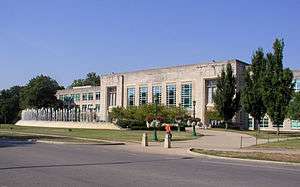Jacobs School of Music
| Indiana University Jacobs School of Music | |
|---|---|
 | |
| Address | |
|
1201 E 3rd Street, Merrill Hall 003 Bloomington, IN | |
| Information | |
| Type | Public |
| Established | 1921 |
| Dean | Gwyn Richards |
| Enrollment | Approximately 1,600 |
| Campus | Bloomington, IN, U.S. |
| Information | 812 855 1583 |
| Website | http://music.indiana.edu |
The Jacobs School of Music of Indiana University in Bloomington, Indiana, is a music conservatory established in 1921. Until 2005, it was known as the Indiana University School of Music. It has more than 1,600 students, approximately half of whom are undergraduates, with the second largest enrollment of all music schools accredited by the National Association of Schools of Music.[1]
History
In 1907, Charles Campbell arranged for a recital of the Schellschmidt Quartet of Indianapolis, the proceeds of which established a music fund, "to lead ultimately to the equipment of a school of music in the university." In 1909, he offered a series of noncredit lectures on the history of music, which eventually led to a full-fledged music department. In 1919 Barzille Merrill took the position of department head and worked to create a separate school of music. He campaigned for a new music building as well, which was dedicated in 1937, and renamed Merril Hall in 1989. In 1921 the Department of Music officially became the School of Music.
In 1938 Robert L. Sanders was appointed Dean and remains the school's youngest-ever dean. Through his efforts, the school gained membership in the National Association of Schools of Music and built the Hall of Music (now known as the Indiana University Auditorium). In 1941 the Indiana University Auditorium was dedicated and offered 15 events including appearances by the Ballet Russe de Monte Carlo and the San Carlo Opera Company.
In 1942 the school staged its first full opera. Cavalleria Rusticana. That year the Metropolitan Opera Company visited IU for the first time, performing Aida, and would return again for the next 15 years, presenting two operas each visit.
In 1982 Leonard Bernstein spent six weeks at the school to work on his final opera, A Quiet Place. In 1980, the School of Music launched a weekly radio chamber music series produced by WFIU. In its first year, the series featured student and faculty performers and was broadcast on six Indiana stations. By 1981 (and through 1984), "Music from Indiana" had achieved national syndication on American Public Radio, and in 1983, the number of stations carrying the program had jumped to 54.
In 2005 the school announced it had received a gift of $40.6 million from Barbara and David H. Jacobs for the school of music. At the time, it was the largest single gift for a school of music at a public university and it is also the largest single gift ever given by individuals to IU. The school will use $20 million of the gift to endow graduate student fellowships and $10 million to endow undergraduate scholarships. The gift also establishes endowed faculty positions, including the Dean Charles H. Webb Chair in Music, the Henry A. Upper Chair in Music and the David H. Jacobs Chair in Music..
In 2009, the school received a gift from the family of Leonard Bernstein that included the entire contents of Bernstein's conducting studio.
Academics and programs
Admissions
Admission to the Jacobs School of Music is done by a live or recorded audition only. The overall acceptance rate is generally about 25 percent for undergraduate students and about 30 percent for graduate students . However, acceptance rates vary greatly between programs. Each freshman class contains about 200 new students.
Ensembles
Students in most degree programs at the school are required to participate in an ensemble during every semester spent at the school. Depending on the student's degree program, he or she may be required to participate in specific ensembles. The majority of ensembles are auditioned.
Owing to the large size of the school, there are thirteen choirs, eight bands and seven orchestras at the school . They encompass a broad range size and musical styles and include the Singing Hoosiers, Opera Chorus, Wind Ensemble, Marching Hundred, Chamber Orchestra and the Philharmonic Orchestra.
Contemporary
The school is home to two of the nation's premier contemporary music ensembles. :
- New Music Ensemble, founded by former Prof. Frederick A. Fox in 1975, and currently directed by Prof. David Dzubay: Composed of the top musicians from the school of music, this group contains; 1 flute, 1 oboe, 1 clarinet, 1 bassoon, 1 saxophone, 1 horn, 1 trumpet, 1 trombone, 1 tuba, 2 pianists, 1 harp, 2-3 percussionists, 2 violins, 1 viola, 1 cello and 1 bass
- NOTUS, formerly known as the Contemporary Vocal Ensemble, a 24-voice choir that specializes in contemporary choral repertoire and especially the works of living composers. Directed by Dominick DiOrio, the ensemble frequently premieres works by students, faculty, and emerging professional composers and frequently tours nationally. NOTUS: IU Contemporary Vocal Ensemble
Programs of study
The school offers Bachelor of Music (B.M.) degrees, Master of Arts (M.A.) degrees, Master of Music (M.M.) degrees, Doctor of Philosophy (Ph.D.) degrees, and Doctor of Music (D.M.) degrees, among others, in a large and diverse number of musical fields. The school also awards a "Performer's Certificate" or "Artist's Diploma" to students who demonstrate exceptionally outstanding performance ability. Additionally, it is possible for students to enroll in a unique degree program available at Indiana University known as the B.S.O.F. or Bachelor of Science in an Outside Field in some select areas of study so that students may diversify their education outside of the standard prescribed curriculum.
Awards and honors for the Jacobs School of Music
Honors for the school include being ranked first in the nation by Change magazine, The Chronicle of Higher Education, and U.S. News & World Report. The IU School of Music as a whole was recently listed first among the "Top Ten Voice Schools in America" by Classical Singer. IU School of Music voice students are frequent winners in the Metropolitan Opera National Council Auditions in New York City each spring. The school has had five grand winners in the last five years and 33 grand winners overall. An unparalleled twenty students and alumni have received BMI Student Composer Awards. In April 1981, the opera program became the first non-professional company to stage an opera at the Metropolitan Opera in New York City,
Faculty
The school has more than 170 full-time faculty members that include performers, scholars, and teachers of international renown. In addition, many top musicians and scholars come to the school each year to give master classes and guest lectures or to serve as visiting artistic directors, conductors, and faculty. Over the last few years the school has hired pianists André Watts and Arnaldo Cohen, violinist Jaime Laredo, and sopranos Sylvia McNair and Carol Vaness as faculty members. Violinist Joshua Bell and conductor Leonard Slatkin recently joined the faculty.
Other notable faculty members include:
- Atar Arad, viola
- David Baker, jazz cello and educator
- Edmund Battersby, piano
- Joshua Bell, violin
- Bruce Bransby, double bass
- Wolfgang Brendel, Baritone
- James Campbell, clarinet
- Ray Cramer, conductor and Emeritus Director of Bands
- Alan de Veritch, viola
- Eli Eban, clarinet
- David Effron, conductor
- Eileen Farrell, Soprano
- Josef Gingold, violin
- Margaret Harshaw, opera singer
- Howard Klug, clarinet
- Tibor Kozma, conductor
- Martha Lipton, Soprano
- Kathryn Lukas, flute
- Elizabeth Mannion, mezzo soprano
- Susann McDonald, harp
- Sylvia McNair, soprano
- Otis Murphy, classical saxophone
- Emile Naoumoff, piano
- Jeff Nelsen, horn
- Nokuthula Ngwenyama, viola
- Eugene O'Brien, composition
- Harvey Phillips, tuba
- Menahem Pressler, piano and commander in Order of Arts and Letters
- John Rommel, trumpet
- Leonard Slatkin, conductor
- János Starker, cello
- Carol Vaness, soprano
- Violette Verdy, ballet
- Iannis Xenakis, composition
Facilities
The school's facilities, including five buildings located in the heart of the IU Bloomington campus, comprise recital halls, more than 170 practice rooms, choral and instrumental rehearsal rooms, and more than 100 offices and studios.
Musical Arts Center
The Musical Arts Center, known as the MAC, is the school's largest performance facility and was built in 1972. It is equipped with an opera theater with European-style seating for 1,460 and room for a 100-piece orchestra, as well as studios, classrooms, and rehearsal facilities for music and ballet, with the backstage area occupying more than half of the building. The 90x60 foot stage is often compared to that of the Metropolitan Opera House in New York, while the unsegmented seating design in the orchestral seats is based on the seating arrangement of the Bayreuth Festspielhaus.
Peau Rouge Indiana, a large sculpture by Alexander Calder, sits on the lawn in front of the MAC. It was renovated over the course of two months during the Fall 2007 semester.
Simon Music Center
The Simon Music Center (pictured at the top of the page) opened after an extensive renovation in 1995 and houses the William and Gayle Cook Music Library, Auer Hall, Ford-Crawford Hall, Sweeney Lecture Hall, the Latin American Music Center, classrooms, and administrative and faculty offices.
Notable alumni
- Jamey Aebersold, jazz educator
- Kenny Aronoff, drumset
- David Baker, jazz composer
- Noah Bendix-Balgley, violinist, 1st concertmaster of Berlin Philharmonic
- Joshua Bell, violinist
- Jonathan Biss, pianist, professor at Curtis Institute of Music
- Chris Botti, jazz trumpeter
- Michael Brecker, jazz saxophonist
- Carl Broemel, lead guitarist/vocalist/saxophone for My Morning Jacket
- Angela Brown, soprano
- Lawrence Brownlee, tenor
- Frederic Chiu, pianist
- John Clayton, jazz and classical bassist, composer and arranger
- Richard Cowan, opera singer
- Jeremy Denk, pianist
- Alexandra du Bois, composer
- Peter Erskine, jazz drummer and educator
- Jack Everly, conductor
- Miriam Fried, violinist and pedagogue, winner of Queen Elisabeth Music Competition
- Vivica Genaux, mezzo soprano
- Tom Gullion, jazz saxophonist
- Jeff Hamilton, jazz drummer
- Hu Nai-yuan, violinist, winner of Queen Elisabeth Music Competition
- Bruce Hubbard, Broadway, Metropolitan Opera baritone and recording artist
- Jacques Israelievitch, violinist, former concertmaster of the Toronto Symphony
- Booker T. Jones, songwriter, producer, frontman for Booker T. and the MGs
- Karen Kamensek, conductor, general music director Staatsoper Hannover
- Paul Katz, cellist, founding member of the Cleveland Quartet
- Kate Lindsey, mezzo soprano
- Sylvia McNair, soprano
- Edgar Meyer, bassist and pedagogue, MacArthur Fellow, professor at Curtis Institute
- Fatma Ceren Necipoğlu, Turkish harpist
- Michael Palmer, conductor
- Shawn Pelton, session drummer
- Larry Ridley, jazz bassist and music educator
- Miguel Roig-Francolí, composer and music theorist
- Byron Schenkman, harpsichordist, pianist
- Leonard Slatkin, conductor, music director of Detroit Symphony Orchestra
- Michael Sweeney, composer of Concert Band literature
- Gwen Thompson, violinist
- Doron Toister, composer and cellist
- Michael Weiss, jazz pianist and composer
- Pharez Whitted, jazz trumpet
References
- ↑ HEADS Data – Special Report, 2010-11, National Association of Schools of Music Note: For more than 20 years, University of North Texas College of Music enrollment has tracked closely to that of Indiana. Institutions that include Berklee, Juilliard, Manhattan School of Music are not among the 627 NASM members. One non-NASM music school has a student enrollment larger than North Texas – Berklee.
North Texas Indiana 2006-07 1,649 1,638 2007-08 1,659 1,633 2008-09 1,608 1,554 2009-10 1,635 1,557 2010-11 1,596 1,578
External links
Coordinates: 39°9′55″N 86°31′2″W / 39.16528°N 86.51722°W
